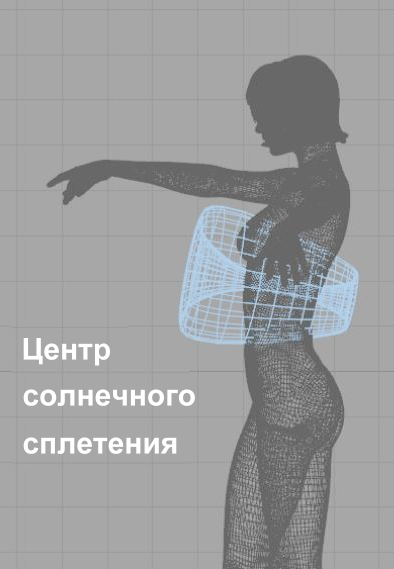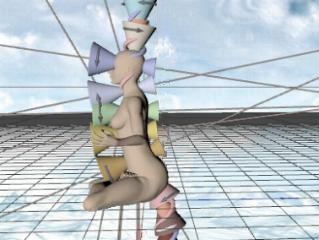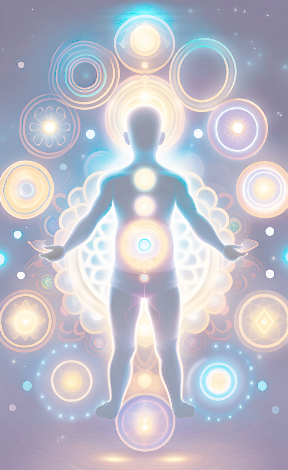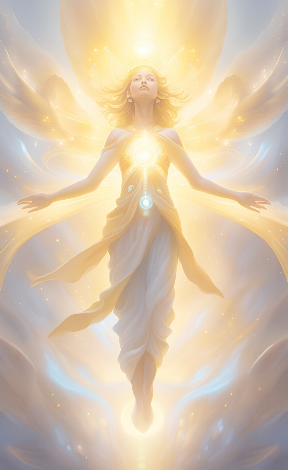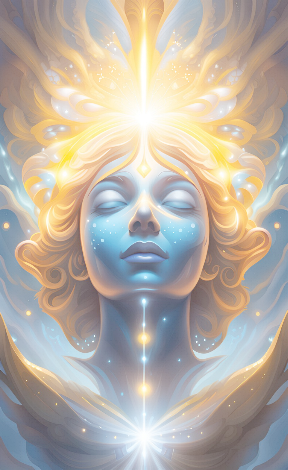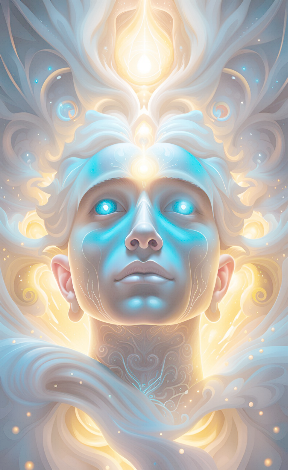Beyond Matter. Chakra: Level, Plan, and Sub-plan
How do people become philosophers? It's very simple: take some meaningless thesis, say: "Anarchy is the mother of order," add: "and daughter," — and you are already a spontaneous dialectician.
Podvodny. "Selected Aphorisms."
Evolutionary Levels of Chakras
We've examined the division of the energy flow into seven broad bands corresponding to the bodies (Atmanic, Buddhi, and so on), and within each body, into seven levels called chakras. Every person (as well as society as a whole, and any group of people — a family, a factory collective, a country, an ethnic group) exists at a certain evolutionary level, characterized by a chakra or, more precisely, a triad: level-plane-subplane. As development progresses, this refined level changes — generally increasing, but sometimes decreasing for a time.
Chakras open, meaning they become capable of transmitting a strong energy flow, as a person's evolutionary development progresses. Nevertheless, even in the most underdeveloped homo sapiens, all of them are slightly ajar, and at certain moments of their life, they can open quite strongly. A developed person differs from an undeveloped one by a certain average degree of chakra openness, and a harmonious person from a disharmonious one by the uniformity of their opening and the absence of damage that makes the energy flow through the chakra turbulent. During evolutionary leaps, unprepared chakras open as if by force, like a flower from an unripe bud, and although they can transmit a strong flow for some time, it's difficult for the person to sustain it due to strong disharmonious effects in their external and internal life, accompanying the turbulence of this flow. Having fallen back to the initial level or near it, the person experiences mixed feelings of disappointment and relief: after all, that life wasn't for them. This is how a former department head feels, who was carried by an administrative wave into the chair of deputy minister, and then thrown back into their native institute.
It's not entirely correct to speak of the opening of chakras in general. Firstly, one needs to specify the particular human body in question, because, for example, the mental Vishuddha and the physical Vishuddha can be developed completely differently (perfection of thought and the physical body rarely accompany each other in our time). Secondly, it's important to clarify whether we are talking about a level, a plane, or a subplane, because Sahasrara as a chakra of a certain body might be weakly developed, while as a plan, say, of Svadhisthana, it might be open — popular religiosity serves as a vivid example of this.
In this nomenclature, there are $7^4 = 2401$ possible combinations, and the author is, of course, unable to describe them all, especially since at any given moment, different chakras (as well as planes and subplanes) can be active on a person's different bodies. Thus, the number of (in principle) possible energy states is equal to $(7^3)^7 = 343^7 = 6 \times 10^{17}$, a number with seventeen zeros, incomprehensible to the mind.
It takes a lot of wisdom to recognize and feel the specificity of the vibrations of your body levels, and humility to accept the misalignment of these levels... and then visible evolutionary growth begins, forcing a person to adapt anew to new external and internal conditions and to seek new hidden possibilities and reserves within themselves, since old ones won't suffice — and this needs to be understood in time, just as it is sometimes very difficult to accept, or even just acknowledge, that in a new position, in situations very similar to old ones, old methods somehow don't work.
Muladhara
Muladhara — the surviving person, whose main life background is the struggle for existence in the most literal sense. Their environment is so hostile to them that it constitutes a constant source of danger to life. This is a savage, a primitive person, a slave, a soldier, a prisoner. It is constantly active, for example, in participants of a difficult hike in natural conditions where finding food and ensuring minimal living conditions requires considerable effort. Thus, the joys of Muladhara are a hard-earned dinner, a quiet night after a hard day, money earned with difficulty necessary for the most urgent needs, and safe living conditions for the family.
Svadhisthana
Svadhisthana - the living person. This means the problem of survival has been solved, and there is confidence in tomorrow for oneself and one's family. Here, the surrounding environment is friendly, or at least poses no significant danger to life, and at the same time provides conditions for abundant flourishing and reproduction — if there is desire and energy. It's active when a person (or a people) emerges from poverty with its Muladhara pathos (the highest happiness is a piece of cheese suddenly fallen from the sky to fill an eternally hungry belly, or a long-awaited bonus that can partially patch the gaping holes in the family budget). They then enter a zone of prosperity with its entirely different laws and problems. Now one can comfortably settle into the surrounding space, stating with satisfaction, "We are well situated!" One can eat deliciously, carefully studying the menu, after which they might indulge in more reprehensible carnal pleasures. The ideal of a Svadhisthana person is a full house, a family with many children and, possibly, wives and concubines. Here, family and children play a very significant role: family (in particular, sexual life) is a way of expanding and embodying one's ego, and children are seen as an extension of oneself into the future, i.e., a guarantee of personal immortality.
Manipura
Manipura — the controlling person. Here, the main background of life is a competition of strength with nature and with one's own kind. That nature, which at Svadhisthana generously nourished, must now be "conquered" and "managed"; people who lived quite peacefully in a community suddenly become fierce and want to dominate each other; intrigues aimed at gaining such power become a natural background of life in all its manifestations. The Manipura person is a strong-willed person in the usual sense of the phrase, meaning a person whose explicitly expressed will is difficult to resist. Another key word for Manipura's energy is (direct) pressure, which is again, physical force, almost palpable. Manipura is the chakra of athletes ("sports anger"), officials, and rigid religious preachers who hammer faith into human souls with a whip. The celebration of Manipura is the ecstasy of a teacher's power, having strictly disciplined a class, a military parade with perfectly trained troops, or a similar scene within a family, and any authoritative act within a compliant bureaucratic system. In general, as much as Svadhisthana feels warm and, at first glance, "soulful," Manipura is rigid and cold — and yet its temptation, that is, the temptation of direct power over the world, is subtler and more dangerous than the temptation of luxurious idleness and lazy sexuality of Svadhisthana.
Anahata
Anahata — the loving person. Here, the main background of a person's life is an inexpressible love that they feel directed towards them from everywhere. Of course, any events can occur against this background, but the Divine light illuminating everything that happens never fades. This light also comes from the person themselves, but for those at the Manipura level, it is somewhat cold (though, of course, pleasant) and diluted, as from their point of view, higher love is good in moderate quantities, like a delicate sauce to a roast. For the Anahata person themselves, this light represents the foundation of life, and in its absence, they literally suffocate. Love for the world is the true content of all their actions and deeds, but at the Anahata level, it does not find clear expression in them, and to feel it, one must be attuned accordingly. Only then will its true power become evident. The Anahata flow gives an inexpressible sense of Divine presence, which can be experienced by a person as an elevated love of the world (or a part of it) for a person, but this is not necessarily the case. The light in the Anahata flows can appear as a special vision of the subtle harmony of the world, or as an inexpressible sacred knowledge, or as a feeling of the hidden meaningfulness of one's life path, and in many other ways. The colors of the chakras traditionally follow the rainbow: Muladhara — red, Svadhisthana — orange, Manipura — yellow, Anahata — green, Vishuddha — blue, Sahasrara — violet. The green flows of Anahata are cold; they create a sense of detachment from the world, but also of immense potential power over it, as Anahata is higher than Manipura. They bring a person the joy of liberation from the dense shackles of the manifested world and a clear, though intuitive, connection with the subtle. At the same time, in Anahata, the subtle world is not yet manifested in any form. It is as if it says: "I am the primordial source, the cause and the secret content of the visible world, but I am not it." Therefore, the love of Anahata people is always somewhat distantly detached; it can be very effective, but not personally warm. The Anahata person sees God behind another person, but not in their immediate manifestations: sufferings, problems, or whims. In other words, they clearly see and love the higher principle in people, but not their worldly shells. Similarly, an Anahata person can see the high harmony behind the external world, but which has not found adequate expression in it (in their perception), or the flawless intertwining of the vicissitudes of their acquaintances' lives, but not their (acquaintances') specific behavior in their own lives, i.e., they can feel the wisdom of Providence's design, but not its executors of roles.
Vishuddha
Vishuddha - the accomplished person, or master, who can find the precise expression for the light of energies of a high egregore, their leading one. Looking at this person, their behavior, gestures, actions, it seems as if one is witnessing a manifested miracle. They are so perfect, as if Krishna has incarnated on Earth again. Next to such a person, the surrounding world fades, which is why they are usually tried to be isolated in some way, for example, placed on a stage, while the surroundings modestly take their seats in the audience and try not to interfere. The great ones emerge at this level: beauties (physical Vishuddha), mimes (etheric Vishuddha — perfection of gesture), actors (astral Vishuddha — perfect expression of emotions), enlighteners (mental Vishuddha — perfect articulation of thought), politicians and financiers (causal Vishuddha — perfect management of the flow of events), psychologists and moralists (buddhi Vishuddha — perfect articulation of life views and positions), and religious preachers (atmanic Vishuddha — perfect articulation of the highest ideal and goals of life). The Vishuddha person is an ancient God, perfect in their manifestation, which is always filled with divine love and is one or another of its formulations and embodiments. But only an Anahata person can see and appreciate this. Vishuddha is the chakra of artists with a strong religious channel. These are icon painters, composers and performers of spiritual music, and so on. Of course, "secular" art can also flow on Vishuddha currents, but then in it, regardless of the plot, one still feels a Divine presence and the perfection of expressive means.
The perfection of form in itself, irrespective of the embodiment of the Divine within it. Such is the temptation of Vishuddha and Gagttungr's dream for creative people, whom he would like to force to create perfect forms with hellish content, that is, to effectively transmit his will through them. At the Vishuddha level, people incarnate very rarely, and it is usually achieved meditativley: by an actor on stage, by an artist in front of a canvas, and so on. And often, the level of Anahata's opening does not correspond to the level of Vishuddha's opening, which leads to the creation of a dead work of art, in which, upon careful examination, one can usually see some features of Gagttungr. The Anahata level for a creator is the torment of muteness. But a high egregore opens Vishuddha to a person when it deems them ready to fulfill a high mission of its incarnation in the world. And the mere practice of technique, without its sanction, is nothing more than preparation of a good conductor (human tool) for a planetary demon.
Ajna
Ajna - the wise and versatile person, connected to many high egregors and able to establish contact between them, while being at the Vishuddha level with each individually. They are, so to speak, the supreme egregorial diplomat, or synthesizer. On the physical body, this is, for example, a master — a golden-handed artisan who has mastered numerous technologies to perfection and is capable of shoeing a flea with programmable control; on the etheric — a multi-sport athlete; on the astral — a writer who creates symphonies from the emotional manifestations of their characters; on the mental — a scientist working at the intersection of sciences and creating synthetic concepts and models; on the causal — a brilliant diplomat, a major international politician; on the buddhic — a person who coordinates the mutual ethics of various high egregors, for example, finding common ground between unfriendly nations; on the atmanic — the creator of a strong religion that unites very different sects and movements (an ecumenist). Here, sectarianism is overcome and the principle of spiritual cooperation is realized, which is very difficult for high egregors. At a low level, this materializes as a certain eclecticism; at a high level, as a synthetic religious-philosophical Teaching leading large nations.
Sahasrara
Sahasrara - the God-man. Here, the main goal is achieved — the person merges with the Universe, and through their every movement and manifestation, the vibrations of the Absolute are directly transmitted. Keywords: fullness, unity with the world, mystical rapture of being. If in Anahata God manifested indirectly, behind the world, in Vishuddha a high egregore formed through man for the world, and in Ajna various high egregors clarified their relationships with each other through man, then with an open Sahasrara, a person gets the feeling that the whole world is God, and they themselves are primarily God too, or rather, some obedient emanation of His, closely connected with all His other emanations, which are other people, trees, bushes, cinder blocks, and everything else without exception. Here, feelings of the total unity of the world are characteristic, as well as the meaningfulness of its every manifestation and dynamics of development: both as a whole and for any of its particles in particular. With an open Sahasrara, everything finds its place, and such as it is; everything is filled with love, grace, and higher meaning. The person feels like a happy and beloved servant of the Great Master, who personally and with pleasure takes care of all the details of the person's life.
The temptation of Sahasrara lies in the imperceptible disruption of service when the channel leading the person is intercepted by Gagttungr, and then lifelong slavery (a zombie variant) is not excluded. An honest religious person, however, will feel that the source of invultuation has changed, and will prefer to live without the channel rather than serve a rigid egregore.
